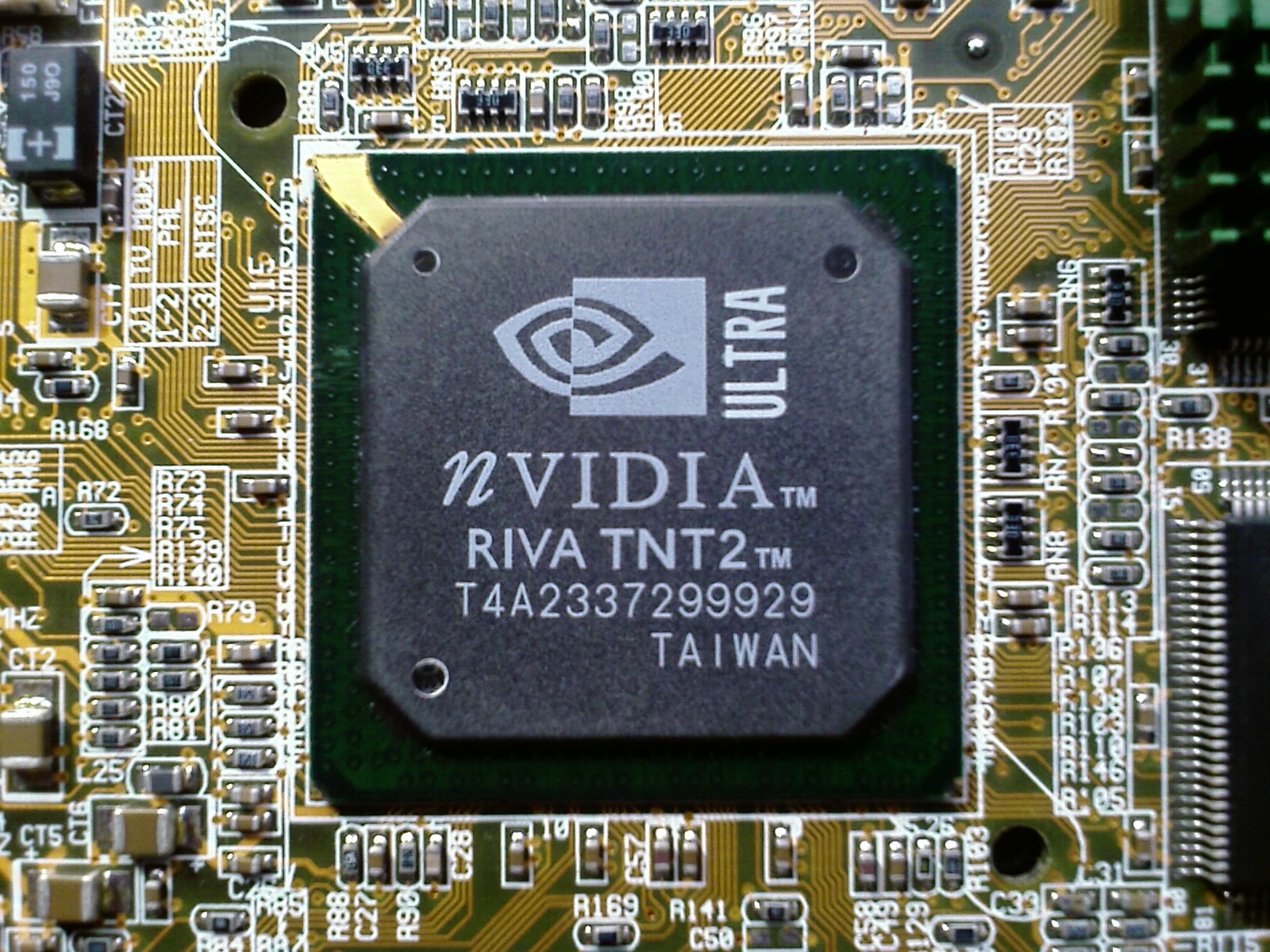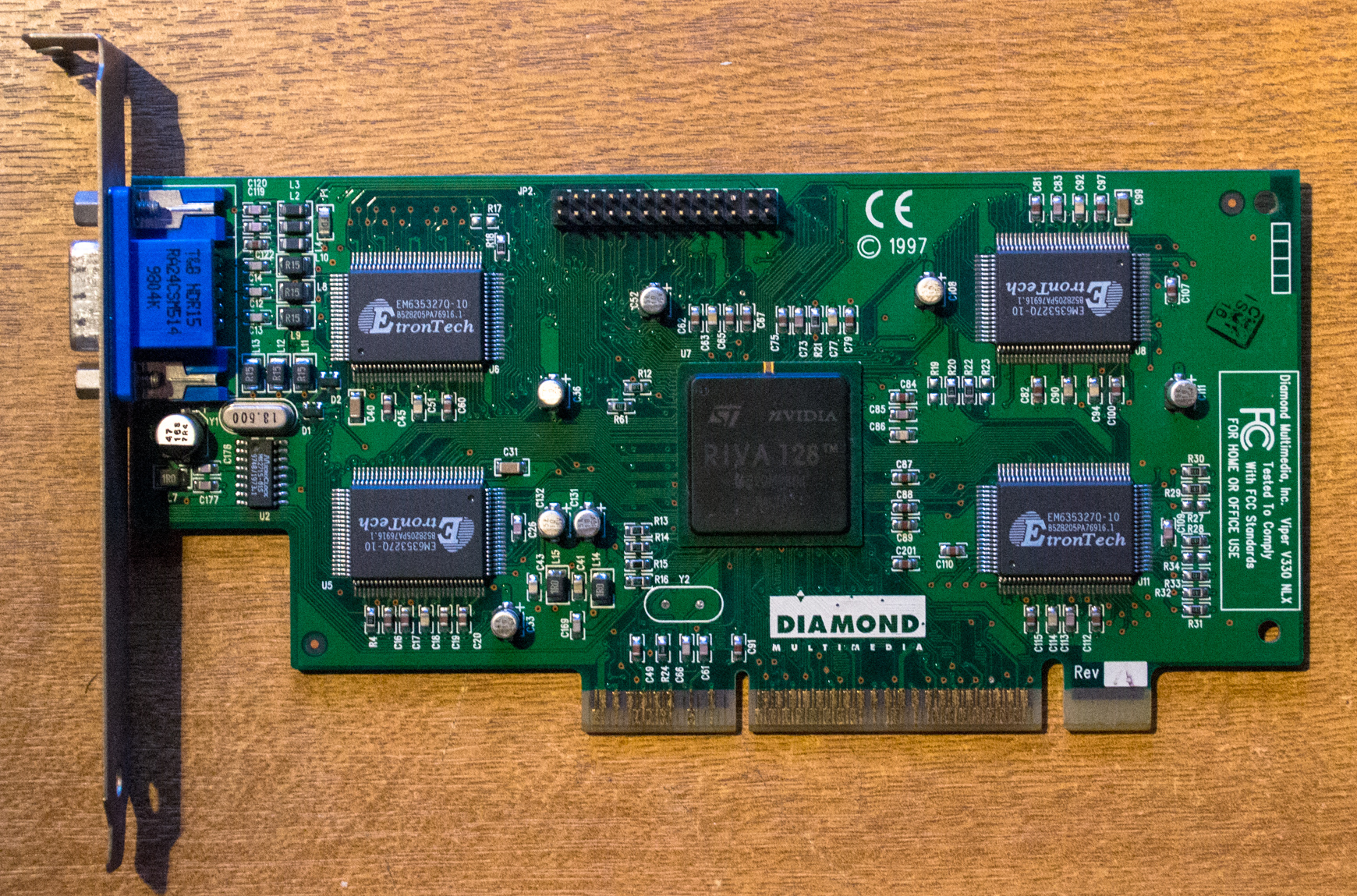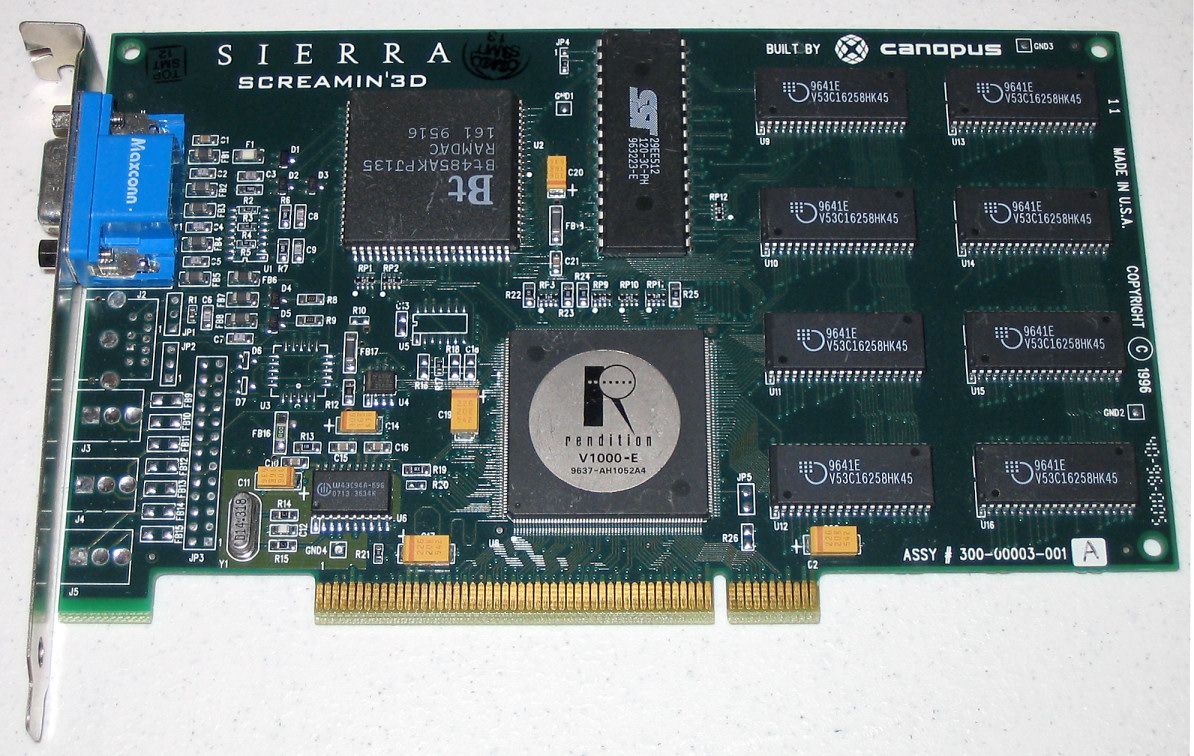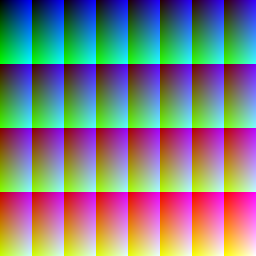|
Voodoo2
The Voodoo2 (or Voodoo2) is a set of three specialized 3D graphics chips on a single chipset setup, made by 3dfx. It was released in February 1998 as a replacement for the original Voodoo Graphics chipset. The card runs at a chipset clock rate of 90 MHz and uses 100 MHz EDO DRAM, and is available for the PCI interface. The Voodoo2 comes in two models, one with 8 MB RAM and one with 12 MB RAM. The 8 MB card has 2 MB of memory per texture mapping unit (TMU) vs. 4 MB on the 12 MB model. The 4 MB framebuffer on both cards support a maximum screen resolution of 800 × 600, while the increased texture memory on the 12 MB card allows more detailed textures. Some boards with 8 MB can be upgraded to 12 MB with an additional daughter board. Each of the three chips present on the card has its own 64-bit RAM interface, giving the card a "total" bus width of 192 bits or 800MB/s per chip. The Voodoo2 has an increased chip-count compared to the original two-chip Voodoo ... [...More Info...] [...Related Items...] OR: [Wikipedia] [Google] [Baidu] |
3dfx
3dfx Interactive was an American technology company headquartered in San Jose, California, founded in 1994, that specialized in the manufacturing of 3D graphics processing units, and later, video cards. It was a pioneer in the field from the late 1990s until 2000. The company's original product was the Voodoo Graphics, an add-in card that implemented hardware acceleration of 3D graphics. The hardware accelerated only 3D rendering, relying on the PC's current video card for 2D support. Despite this limitation, the Voodoo Graphics product and its follow-up, Voodoo2, were popular. It became standard for 3D games to offer support for the company's Glide API. The success of the company's products led to renewed interest in 3D gaming, and by the second half of the 1990s, products combining a 2D output with reasonable 3D performance were appearing. This was accelerated by the introduction of Microsoft's Direct3D, which provided a single high-performance API that could be implemented ... [...More Info...] [...Related Items...] OR: [Wikipedia] [Google] [Baidu] |
Voodoo Banshee
3dfx Interactive was an American technology company headquartered in San Jose, California, founded in 1994, that specialized in the manufacturing of 3D graphics processing units, and later, video cards. It was a pioneer in the field from the late 1990s until 2000. The company's original product was the Voodoo Graphics, an add-in card that implemented hardware acceleration of 3D graphics. The hardware accelerated only 3D rendering, relying on the PC's current video card for 2D support. Despite this limitation, the Voodoo Graphics product and its follow-up, Voodoo2, were popular. It became standard for 3D games to offer support for the company's Glide API. The success of the company's products led to renewed interest in 3D gaming, and by the second half of the 1990s, products combining a 2D output with reasonable 3D performance were appearing. This was accelerated by the introduction of Microsoft's Direct3D, which provided a single high-performance API that could be implemente ... [...More Info...] [...Related Items...] OR: [Wikipedia] [Google] [Baidu] |
Voodoo3
Voodoo3 was a series of computer gaming video cards manufactured and designed by 3dfx Interactive. It was the successor to the company's high-end Voodoo2 line and was based heavily upon the older Voodoo Banshee product. Voodoo3 was announced at COMDEX '98 and arrived on store shelves in early 1999. The Voodoo3 line was the first product manufactured by the combined STB Systems and 3dfx. History The 'Avenger' graphics core was originally conceived immediately after Banshee. Due to mis-management by 3dfx, this caused the next-generation 'Rampage' project to suffer delays which would prove to be fatal to the entire company. Avenger was pushed to the forefront as it offered a quicker time to market than the already delayed Rampage. Avenger was no more than the Banshee core with a second texture mapping unit (TMU) added - the same TMU which Banshee lost compared to Voodoo2. Avenger was thus merely a Voodoo2 with an integrated 128-bit 2D video accelerator and twice the clock speed. ... [...More Info...] [...Related Items...] OR: [Wikipedia] [Google] [Baidu] |
RIVA TNT2
The RIVA TNT2 is a graphics processing unit manufactured by Nvidia starting in early 1999. The chip is codenamed "NV5" because it is the 5th graphics chip design by Nvidia, succeeding the RIVA TNT (NV4). RIVA is an acronym for ''Real-time Interactive Video and Animation accelerator''.RIVA 128 Brochure Nvidia, accessed October 9, 2007. The "TNT" suffix refers to the chip's ability to work on two s at once (''TwiN Texel'').TNT2 Nvidia, accessed October 12, 2007. Nvidia removed RIVA from the name later in the chip's l ... [...More Info...] [...Related Items...] OR: [Wikipedia] [Google] [Baidu] |
Scan-Line Interleave
Scan-Line Interleave (SLI) from 3dfx is a method for linking two (or more) video cards or chips together to produce a single output. It is an application of parallel processing for computer graphics, meant to increase the processing power available for graphics. SLI from 3dfx was introduced in 1998 and used in the Voodoo2 line of graphics accelerators. However, the original Voodoo Graphics card and the VSA-100 were also SLI-capable. Nvidia Corporation reintroduced the SLI acronym in 2004 (though it now stands for Scalable Link Interface). NVIDIA's SLI, compared to 3dfx's SLI, is modernized to use graphics cards interfaced over the PCI Express bus. Function 3dfx's SLI design was the first attempt, in the consumer PC market, at combining the rendering power of two video cards. The two 3dfx cards were connected by a small ribbon cable inside the PC. This cable shared graphics and synchronization information between the cards. Each 3dfx card rendered alternating horizontal lines ... [...More Info...] [...Related Items...] OR: [Wikipedia] [Google] [Baidu] |
Texture Mapping Unit
In computer graphics, a texture mapping unit (TMU) is a component in modern graphics processing units (GPUs). They are able to rotate, resize, and distort a bitmap image to be placed onto an arbitrary plane of a given 3D model as a texture, in a process called texture mapping. In modern graphics cards it is implemented as a discrete stage in a graphics pipeline, whereas when first introduced it was implemented as a separate processor, e.g. as seen on the Voodoo2 graphics card. Background and history The TMU came about due to the compute demands of sampling and transforming a flat image (as the texture map) to the correct angle and perspective it would need to be in 3D space. The compute operation is a large matrix multiply, which CPUs of the time (early Pentiums) could not cope with at acceptable performance. In 2013, TMUs are part of the shader pipeline and decoupled from the Render Output Pipelines (ROPs). For example, in AMD's Cypress GPU, each shader pipeline (of which the ... [...More Info...] [...Related Items...] OR: [Wikipedia] [Google] [Baidu] |
RIVA 128
Released in August 1997 by Nvidia, the RIVA 128, or "NV3", was one of the first consumer graphics processing units to integrate 3D acceleration in addition to traditional 2D and video acceleration. Its name is an acronym for ''Real-time Interactive Video and Animation accelerator''.RIVA 128 Brochure Nvidia, accessed October 9, 2007. Following the less successful "NV1" accelerator, the RIVA 128 was the first product to gain Nvidia widespread recognition. It was also a major change in technological direction for Nvidia. 
[...More Info...] [...Related Items...] OR: [Wikipedia] [Google] [Baidu] |
Rendition (company)
Rendition, Inc., was a maker of 3D computer graphics chipsets in the mid to late 1990s. They were known for products such as the Vérité 1000 and Vérité 2x00 and for being one of the first 3D chipset makers to directly work with ''Quake (video game), Quake'' developer John Carmack to make a hardware-accelerated version of the game (vQuake). Rendition's major competitor at the time was 3Dfx. Their proprietary rendering APIs were Speedy3D (for DOS) and RRedline (for Windows). 3D Chipsets Vérité V1000 Released in 1996, Rendition's V1000 chipset was notable for its Reduced instruction set computer, RISC-based architecture. The V1000 was the first PC graphics card to utilize a programmable core to Rendering (computer graphics), render 3D graphics. V1000 was both faster and more advanced (in terms of features) than competitors such as the Matrox Millennium, ATI Technologies, ATI Rage/3D, and S3 Graphics, S3 Virge3D. Only 3DFX, 3DFX's Voodoo Graphics was faster, but unlike the 3 ... [...More Info...] [...Related Items...] OR: [Wikipedia] [Google] [Baidu] |
GeForce 256
The GeForce 256 is the original release in Nvidia's " GeForce" product-line. Announced on August 31, 1999 and released on October 11, 1999, the GeForce 256 improves on its predecessor ( RIVA TNT2) by increasing the number of fixed pixel pipelines, offloading host geometry calculations to a hardware transform and lighting (T&L) engine, and adding hardware motion compensation for MPEG-2 video. It offered a notably large leap in 3D PC gaming performance and was the first fully Direct3D 7-compliant 3D accelerator. The chip was manufactured by TSMC using its 220 nm CMOS process. There are two versions of the GeForce 256 the SDR version released in October 1999 and the DDR version released in mid-December 1999 each with a different type of SDRAM memory. The SDR version uses SDR SDRAM memory from Samsung Electronics, while the later DDR version uses DDR SDRAM memory from Hyundai Electronics (now SK Hynix). Architecture GeForce 256 was marketed as "the world's first 'G ... [...More Info...] [...Related Items...] OR: [Wikipedia] [Google] [Baidu] |
Highcolour
High color graphics is a method of storing image information in a computer's memory such that each pixel is represented by two bytes. Usually the color is represented by all 16 bits, but some devices also support 15-bit high color. More recently, the term ''high color'' has been used by Microsoft to identify display systems that can make use of more than 8-bits per color channel (10:10:10:2 or 16:16:16:16 rendering formats) from traditional 8-bit per color channel formats. This is a different and distinct usage from the 15-bit (5:5:5) or 16-bit (5:6:5) formats traditionally associated with the phrase ''high color''. 15-bit high color In 15-bit high color, one of the bits of the two bytes is ignored or set aside for an alpha channel, and the remaining 15 bits are split between the red, green, and blue components of the final color. Each of the RGB components has 5 bits associated, giving 2⁵ = 32 intensities of each component. This allows 32768 possible colors for each pixel ... [...More Info...] [...Related Items...] OR: [Wikipedia] [Google] [Baidu] |
RAMDAC
A random-access memory digital-to-analog converter (RAMDAC) is a combination of three fast digital-to-analog converters (DACs) with a small static random-access memory (SRAM) used in computer graphics display controllers or video cards to store the color palette and to generate the analog signals (usually a voltage amplitude) to drive a color monitor. The logical color number from the display memory is fed into the address inputs of the SRAM to select a palette entry to appear on the data output of the SRAM. This entry is composed of three separate values corresponding to the three components (red, green, and blue) of the desired physical color. Each component value is fed to a separate DAC, whose analog output goes to the monitor, and ultimately to one of its three electron guns (or equivalent in non- CRT displays). RAMDACs became obsolete as DVI, HDMI, DisplayPort and other digital interface technology became mainstream, which transfer video data digitally (via transition-minim ... [...More Info...] [...Related Items...] OR: [Wikipedia] [Google] [Baidu] |
Hertz
The hertz (symbol: Hz) is the unit of frequency in the International System of Units (SI), equivalent to one event (or cycle) per second. The hertz is an SI derived unit whose expression in terms of SI base units is s−1, meaning that one hertz is the reciprocal of one second. It is named after Heinrich Rudolf Hertz (1857–1894), the first person to provide conclusive proof of the existence of electromagnetic waves. Hertz are commonly expressed in multiples: kilohertz (kHz), megahertz (MHz), gigahertz (GHz), terahertz (THz). Some of the unit's most common uses are in the description of periodic waveforms and musical tones, particularly those used in radio- and audio-related applications. It is also used to describe the clock speeds at which computers and other electronics are driven. The units are sometimes also used as a representation of the energy of a photon, via the Planck relation ''E'' = ''hν'', where ''E'' is the photon's energy, ''ν'' is its f ... [...More Info...] [...Related Items...] OR: [Wikipedia] [Google] [Baidu] |








_BT458LPJ135.jpg)
